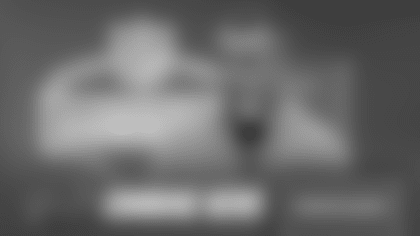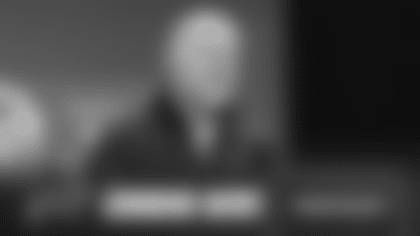This week's observations "From the Booth" come with a caveat--it was difficult to call the game "from the booth" at University of Phoenix Stadium in Arizona. Like many new stadiums, the radio booth has been shifted down to the corner of the bowl, leaving us with very difficult sight lines to call the game.
I know it's inside baseball, but it's nearly impossible to see yard lines and loose balls when you're at one end of the stadium like we were on Sunday. The worst is FedEx Field in Washington, where the radio booth is both on the corner of the stadium and very low.
With all that being said, I did make some observations "from the booth" regarding the Bills and the Cardinals (with the help of some video review after the game).
● It's been a wildly inconsistent first six games for the Bills this year, as demonstrated by their 3-3 record. But if you're looking for the key to finding some consistency for this team, you want to look at physical play in the trenches.
As they did in earlier wins over the Chiefs and the Browns, the Bills built their win in Arizona on solid play by the defensive and offensive lines.
Buffalo got great work from their front four early in the game. On Arizona's second offensive series, the Bills made some big defensive plays that wound up putting points on the board. Kyle Williams manhandled Cardinals Center Lyle Sendlein on Arizona's 1st down at the 13-yard line, and Chris Kelsay simply overpowered left tackle D'Anthony Batiste. The result was a one yard loss by RB LaRod Stephens-Howling. Two plays later, the Bills got what amounted to a team safety, with Williams and Marcel Dareus pushing the pocket, and Chris Kelsay coming in to sack Kevin Kolb in the end zone.
The Bills defensive line had dominant moments throughout the game, including early in the third quarter, when Mario Williams got his second sack of the game. Marcel Dareus outmanned Arizona Guard Adam Snyder on the play, and Mario Williams was able to track down Kolb for a four yard loss.
The lesson is, when the Bills defensive front plays physical football, they can be dominant. They benefited from an undersized and inexperienced Cardinals offensive line. But the key to future Bills victories most likely lies up front.
● The physical play extends to the offensive line as well. Buffalo's third quarter 80-yard touchdown drive was mostly a product of the big boys up front overpowering the Cardinals.
On C.J. Spiller's 33-yard run, Eric Wood engulfed Cardinals DE Calais Campbell, and Andy Levitre handled Arizona DT Darnell Dockett. The result was a big pickup for Spiller on a draw play.
Two plays later, the Bills went with a super-heavy formation at the goal line. They had double tight ends, Corey McIntyre in as a fullback/wingback, and Kyle Williams lined up in the backfield as a blocking back for Fred Jackson. The boys up front did their job, McIntyre and Williams found their blocks, and Fred Jackson was able to squeeze into the end zone for a one yard touchdown run.
● By the way, if you're looking ahead to a potential running back controversy between Jackson and Spiller, you may have to wait awhile. The first person off the bench to congratulate Jackson after his third quarter touchdown run was Spiller. The two have a strong and unusual bond. And while they both are looking for more carries and more production, I wouldn't worry about their relationship being frayed in the near future.
Spiller talked about splitting the workload with Jackson after the game.
"We know that there is only one football, "he said. "You are not going to get as many (touches) as you want. Would you want to? Yeah. But at the end of the day, you are not because there is only one and we have a lot of playmakers on this team. It is a good thing to have. I am glad that we have that problem."
● I agree with the many observers who were not on board with the Bills decision to have Brad Smith try a deep pass with four minutes left in the game, up by three points. I've been looking for the Bills to throw it out of the wildcat--but not here, and not now.
Credit Chan Gailey for taking the blame on this call. And he doesn't mince words.
"We thought we had a chance to hit the homerun and kind of ice the thing right there," he said Monday. "We thought they would be playing run all the way. We had seen the middle of the field open. We did not get it down the middle of the field—which is where it was planned to go. We did not get it there. In hindsight, bad call."
Yes it is, in hindsight. But taking the hindsight away for a moment--consider this. The Bills previous wildcat play went for a 16-yard run by Smith that set up the Fred Jackson touchdown. That had to have the Arizona defense thinking run; in fact you can see the safeties and linebackers cheating up to the line of scrimmage before the snap. The Bills ran a "jet sweep" action by Spiller just before the snap, to further reinforce the run fake.
That left single coverage downfield on Stevie Johnson and Donald Jones, both inviting targets. The biggest problem with the play was the under thrown pass by Brad Smith.
Bad play call--no question. A mortal sin? Hanging offense? Lunacy? Not at all.
As Hall of Famer Marv Levy used to say, "If it doesn't work, you should have done the other thing."






